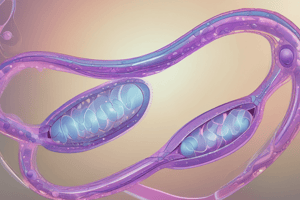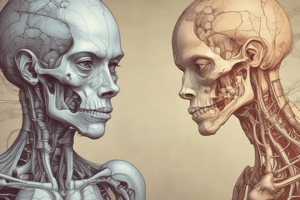Podcast
Questions and Answers
Human gametes are produced by ____.
Human gametes are produced by ____.
meiosis
Normal human gametes carry _____ chromosomes.
Normal human gametes carry _____ chromosomes.
23
A diploid organism whose somatic (nonsex) cells each contain 32 chromosomes produces gametes containing _____ chromosomes.
A diploid organism whose somatic (nonsex) cells each contain 32 chromosomes produces gametes containing _____ chromosomes.
16
Which statement correctly describes how cellular DNA content and ploidy levels change during meiosis I and meiosis II?
Which statement correctly describes how cellular DNA content and ploidy levels change during meiosis I and meiosis II?
Which of these cells is (are) haploid?
Which of these cells is (are) haploid?
What is crossing over?
What is crossing over?
What are recombinant chromosomes?
What are recombinant chromosomes?
Meiosis I produces _____ cells, each of which is _____.
Meiosis I produces _____ cells, each of which is _____.
Meiosis II typically produces _____ cells, each of which is _____.
Meiosis II typically produces _____ cells, each of which is _____.
What occurs during prophase II?
What occurs during prophase II?
What happens during anaphase II?
What happens during anaphase II?
What occurs in telophase II and cytokinesis?
What occurs in telophase II and cytokinesis?
During _____ sister chromatids separate.
During _____ sister chromatids separate.
What happens during telophase I and cytokinesis?
What happens during telophase I and cytokinesis?
At the end of _____ and cytokinesis, haploid cells contain chromosomes that each consist of two sister chromatids.
At the end of _____ and cytokinesis, haploid cells contain chromosomes that each consist of two sister chromatids.
What begins during prophase I?
What begins during prophase I?
What occurs during metaphase II?
What occurs during metaphase II?
What happens during metaphase I?
What happens during metaphase I?
Synapsis occurs during _____.
Synapsis occurs during _____.
Homologous chromosomes migrate to opposite poles during _____.
Homologous chromosomes migrate to opposite poles during _____.
During _____ chromosomes align single file along the equator of a haploid cell.
During _____ chromosomes align single file along the equator of a haploid cell.
Flashcards are hidden until you start studying
Study Notes
Meiosis Basics
- Human gametes are produced through meiosis, leading to haploid cells from a diploid origin.
- Normal human gametes contain 23 chromosomes.
- A diploid organism with 32 chromosomes produces gametes with 16 chromosomes, half the diploid number.
Meiosis Stages
- Meiosis I reduces DNA content from diploid to haploid; it halves the ploidy level.
- Meiosis II maintains the haploid state of cells; DNA content does not change.
Cell Types and Quantity
- After both meiosis I and II, the resulting cells are haploid.
- Meiosis I produces two haploid cells, while meiosis II typically results in four haploid cells.
Genetic Variation
- Crossing over occurs during prophase I, allowing the exchange of genetic material between homologous chromosomes.
- Recombinant chromosomes derive from crossing over, merging DNA from both parents into a single chromosome.
Phases of Meiosis
- Prophase I involves chromosome condensation, synapsis of homologous chromosomes, and the formation of tetrads where crossing over occurs.
- Metaphase I aligns tetrads on the metaphase plate, positioning homologous chromosomes for separation.
- Anaphase I sees homologous chromosomes migrate to opposite poles, leading to the eventual formation of haploid cells.
- Telophase I and cytokinesis finalize the separation, creating two haploid daughter cells, each with chromosomes made of sister chromatids.
Further Steps in Meiosis
- During prophase II, chromosomes reorganize similarly to mitotic prophase, yet the cells remain haploid.
- Metaphase II aligns chromosomes single-file on the metaphase plate, differing only in cell ploidy compared to mitosis.
- Anaphase II involves sister chromatids separating to opposite poles, followed by telophase II, resulting in four haploid cells after cytokinesis.
Key Terms
- Synapsis occurs during prophase I, forming tetrads for genetic exchange.
- Sister chromatids separate during anaphase II, a crucial step in ensuring gametes receive the correct genetic information.
Studying That Suits You
Use AI to generate personalized quizzes and flashcards to suit your learning preferences.




